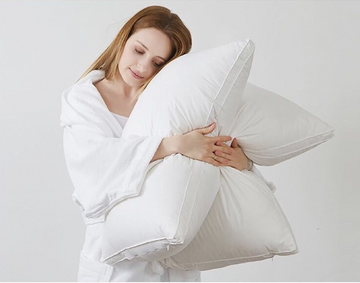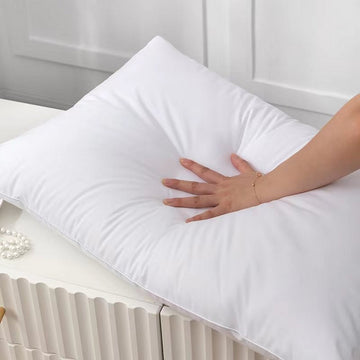Understanding Back Pain and Its Causes
The Anatomy of Back Pain
Back pain stems from complex structures in our bodies. The spine, muscles, and nerves all play roles. Issues within these can trigger pain. A strained muscle can cause sharp pain. Bulging disks can put pressure on nerves. Poor posture can lead to chronic discomfort. It's vital to understand this to choose the right back pillow. A good back support pillow aligns with our spine's natural curve. It should cushion and support these structures to ease pain.
 Common Triggers for Back Pain
Common Triggers for Back Pain
Back pain can arise from a variety of sources. It may be due to a bad posture or a strained muscle. For some, it's a result of heavy lifting or abrupt movements. Others feel pain from long hours of sitting or standing. Stress can also tense the back muscles, leading to discomfort. Even sleeping in an awkward position can trigger back pain. It's important to note that certain medical conditions, like arthritis or sciatica, may also cause back issues. Recognizing these triggers can be the first step in selecting the appropriate back support pillow for bed use or daily activities to alleviate discomfort.
Types of Back Support Pillows
Back Pillows for Bed Use
Back pillows for bed use are designed to support the natural curve of your spine. These pillows can be wedge-shaped or have a contoured design to fit snugly against your back. They often feature memory foam or other materials that mold to your body. This helps reduce stress on your spine while you rest or read in bed. The main aim is to keep your back in a neutral position. Some options include built-in lumbar support for extra relief. Others come with armrests or neck rolls for full-body comfort. For those who need added back support in bed, these pillows are a simple yet effective solution.
Backrest Pillows for Additional Support
Backrest pillows offer extra support. They help keep your spine straight while sitting or lying in bed. Look for those with armrests for added comfort. Many have pockets for books or remotes. These pillows are good for reading or watching TV. They come in different sizes. Choose a size that fits your body well. Some have adjustable neck support for better posture. When you pick a backrest pillow, think about how you will use it.
Specialized Pillows for Back Pain Relief
Specialized pillows for back pain relief are designed with specific features to target and alleviate discomfort in the back. These pillows often incorporate materials like memory foam or gel to provide contoured support that molds to your body’s shape. Some brands offer cooling technology to reduce inflammation and heat discomfort during sleep. The design of these pillows can vary from lumbar rolls for lower back support to full-body wedges that promote proper spinal alignment. When selecting a specialized pillow for back pain relief, it's vital to consider the particular area of your back that needs support and whether the pillow's design is intended for that purpose.
How to Choose the Right Pillow for Back Support
Considerations for Material and Firmness
When picking a back support pillow, material and firmness matter. Soft pillows may feel cozy but won't give enough back support. Firm pillows offer better alignment but can feel too hard. Find a balance for both comfort and back support. Memory foam is a top choice for its ability to shape to your back. Latex is also firm and keeps its shape well over time. When it comes to firmness, medium-firm is often the best for back support. It's firm enough to support the spine but soft enough for comfort.
The Importance of Pillow Shape and Design
The shape and design of a back support pillow are key to its effectiveness. The contour should match the natural curve of your spine. This provides correct support and helps maintain alignment. When choosing a pillow for back support, look for designs that accommodate your specific needs. Consider if the pillow will be used for sleeping or as a backrest. Some designs are tailored for certain positions, such as sitting up in bed. Memory foam pillows can mold to your body for customized support. Other designs feature lumbar support for targeted relief. The right design can ease back pain and improve sleep quality.
Pillow Positioning for Optimal Back Support
Choosing the right pillow for back support involves more than material or design. How you position your pillow is key to relieving back pain. For lower back support, place a pillow under your knees when lying on your back. This reduces the strain on your spine. If you're a side sleeper, a pillow between your legs keeps your hips balanced. This stopping your spine from twisting. For sitting up in bed, use a backrest pillow with arms for full support of your upper body. Always make sure that your pillow aligns with your body's natural curve for restful sleep and a pain-free day.
The Role of Pillows in Managing Chronic Back Pain
How a Proper Pillow Can Prevent Pain Recurrence
For those with chronic back pain, the right pillow is vital in preventing pain's return. A good pillow supports the natural curve of the spine, which prevents strain. This helps keep the back muscles relaxed. It can even ease the stress on spinal discs. Over time, using the proper back support pillow may reduce the chance of pain coming back. Always choose a pillow that maintains its shape and firmness over time. Memory foam is a good option. It molds to your body for better support. Also, be sure the pillow fits your size and sleep style. With the right back support pillow, managing chronic pain can be much easier.
Pillow Recommendations for Chronic Back Sufferers
For chronic back pain sufferers, finding the right pillow is crucial. A contoured memory foam pillow can maintain spine alignment while a lumbar support pillow can ease lower back strain. A body pillow may aid side sleepers in maintaining a neutral position, and a wedge pillow can help with elevated sleeping positions. It's important to invest in quality pillows designed for long-lasting relief and to consult with healthcare providers to ensure the pillow meets individual needs.
The Best Pillow Features for Back Sleepers
Hypoallergenic Options for Sensitive Users
Back sleepers often need pillows that support the natural curve of the spine. For those with allergies, hypoallergenic pillows are a must. These pillows are made from materials that resist common allergens like dust mites, mold, and pet dander. Look for pillows labeled as 'hypoallergenic' or 'allergy-friendly'. They often have covers that are easy to wash. This helps keep irritants at bay. A hypoallergenic back support pillow can improve sleep quality for sensitive users. It supports spinal alignment while protecting from allergies. This is key for a restful night's sleep without discomfort or sneezing.
Ergonomic Designs for Spinal Alignment
For back sleepers, the right pillow is key for spinal health. Look for ergonomic designs that maintain the natural curve of your spine. These pillows are shaped to support your neck and upper back. They fill the gap between your neck and the mattress. This helps keep your spine straight while you sleep. It can reduce stress on your back muscles and joints. Always choose a pillow that feels comfy and provides the support you need.
Care and Maintenance of Back Support Pillows
Cleaning and Hygiene Tips
To keep your back support pillow in top shape, follow these hygiene tips. Remove the cover and wash it according to label directions. Ideally, do this monthly. For the pillow itself, spot clean with a mild detergent. Avoid soaking the inner materials. Allow to air dry fully to prevent mold and damp smells. Use a pillow protector to guard against dust and spills. Keep pets away to reduce allergens and odors. Rotate and fluff your pillow regularly to maintain its shape and support.
When to Replace Your Pillows for Maximum Benefit
Taking proper care of back support pillows is vital for lasting pain relief. Over time, pillows lose their shape and support. This can bring back pain again. You should replace your pillow if:
- It looks lumpy or misshapen.
- The filling is uneven or has clumps.
- It can't support your back well anymore.
- You have had it for more than 1-2 years.
A fresh pillow keeps your back in good shape. It's best to check your pillow often. When you see these signs, get a new one to keep your back healthy.
Expert Tips for Using Back Support Pillows Effectively
Sleeping Postures and Pillow Adjustments
To use back support pillows well, your sleep posture matters. Each position affects your back in a unique way. Side sleepers might place a pillow between their knees. This can align the spine better. Back sleepers may use a pillow under their knees. This aids in reducing lower back strain. Stomach sleepers often face the most strain. A thin pillow under the stomach can help. People with back pain should avoid this position though. Make small adjustments to find what feels best. A small change can reduce pain a lot. If pain stays, try a different pillow or seek medical help.
Integrating Pillows into Daily Back Care Routines
To maximize the benefits of back support pillows, it's essential to integrate them into your daily routine. Start by using the pillow while sitting for extended periods, whether working at a desk or relaxing on the couch. This helps maintain proper posture and reduces strain. For those with a sedentary lifestyle, positioning the backrest pillow to support the lumbar region can prevent back pain before it starts. Incorporate the pillow into your night-time routine as well, ensuring it's placed to provide support where you need it most, such as beneath the knees or behind the back, to ease muscle tension. Make your back pillow a constant companion in your pursuit of comfort and preventative back care.
Conclusion
Summing Up the Benefits of the Right Back Support Pillow
In conclusion, the right back support pillow is key to easing pain. It helps ensure proper spine alignment and reduces strain while sleeping or sitting. With the correct material, shape, and upkeep, it promotes comfort and health. If you choose wisely, it can even prevent future back issues. So, consider a pillow's features and how it fits your needs to enjoy lasting benefits.






